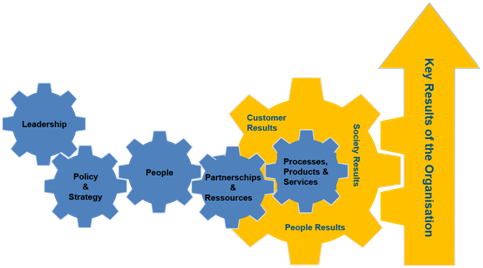A search on Google shows several hundred million entries for excellence – this is one from Marshall Field & Company, a 19th century Chicago department store:
“To do the right thing, at the right time, in the right way; to do some things better than they were ever done before; to eliminate errors; to know both sides of the question; to be courteous; to be an example; to work for the love of work; to anticipate requirements; to develop resources; to recognize no impediments; to master circumstances; to act from reason rather than rule; to be satisfied with nothing short of excellence.”
EFQM defines it as follows:
Excellent organisations achieve and sustain outstanding levels of performance that meet or exceed the expectations of all their stakeholders.
In shorter words, this means:
- They know who their stakeholders are and what they expect.
- They have strategies and a plan to achieve or exceed these expectations.
- They achieve excellent results now.
- They show that they can maintain this performance in the future.
- They show that the causes of these results are understood and effectively managed.
The most important European Excellence Models
In Europe there exist several variations of the of the Excellence Model, but they are closely related to each other and offer sector or task specific views on basically the same concept.
The most important of them are the Common Assessment Framework (http://caf.eipa.eu) , the EFQM Excellence Model (www.efqm.org) and the Project Excellence Model (http://ipma.ch/awards/project-excellence).
The EFQM Excellence Model can be seen as the “mother” of them all. It is regularly reviewed and updated by all its members, which means that each revision has active input from all areas and levels of Industry, associations and academia and thus is grounded on real life developments of the economic environment. EFQM is moderating this process and once the changes are agreed on, the foundation takes over as the publisher and caretaker of the model until the next change.
Some details on the Excellence Models
The Common Assessment Framework (CAF)
CAF is a result of the co-operation among the EU Ministers responsible for Public Administration. A pilot version was presented in May 2000 and revised versions were launched in 2002, 2006 and 2013. A CAF Resource Centre (CAF RC) was created at the European Institute of Public Administration (EIPA) in Maastricht following the decision of the Directors General in charge of public service. It works in close cooperation with the network of CAF national correspondents.
The CAF is an easy-to-use, free tool to assist public-sector organisations across Europe in using quality management techniques to improve their performance. The CAF is a total quality management (TQM) tool which is inspired by the major Total Quality models in general, and by the Excellence Model of the European Foundation for Quality Management (EFQM) in particular. It is especially designed for public-sector organisations, taking into account their characteristics.
The model is based on the premise that excellent results in organisational performance, citizens/customers, people and society are achieved through leadership driving strategy and planning, people, partnerships, resources and processes. It looks at the organisation from different angles at the same time; a holistic approach to organisation performance analysis.
Structure
CAF is closely related to the EFQM Excellence Model and uses nearly the same 9 Criteria, but has a different number of criterion parts (28 instead of 32) and uses a PDCA based scoring system instead of the more detailed RADAR logic.
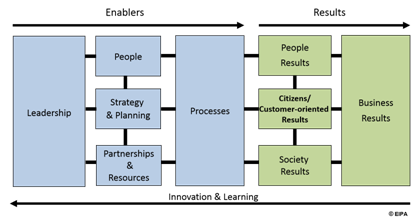
The CAF aims to be a catalyst for a full improvement process within the organisations and has five main purposes:
- To introduce public administrations into the culture of excellence and the principles of TQM
- To guide them progressively to a full fledged “Plan-Do-Check-Act (PCDA)” cycle;
- To facilitate the self-assessment of a public organisation in order to arrive at a diagnosis and improvement actions;
- To act as a bridge across the various models used in quality management;
- To facilitate bench learning between public-sector organisations.
To enable the organisational development, CAF offers specific solutions in the form of examples; e.g. SWOT analysis or Balanced Scorecard. Opposed to this, EFQM tries to stay as neutral as possible to encourage the organisation to fits own best fitting solution.
Highly appreciated in the CAF implementation is the involvement of staff. CAF is a joint project for management and staff and very often CAF is the first occasion in which management and staff meet to discuss the state of affairs of the organisation and the options for the future in order to improve efficiency and effectiveness.
The use of CAF in Europe
Since the year 2000, nearly 2000 public sector organisations all over Europe have used the model and the number of CAF Users is still growing.
In 2009, the CAF External Feedback has been created to further support organisations in using the CAF most effectively in their future quality management journey. This procedure carried out by peers and experts in TQM aims at providing external feedback on the introduction of total quality management with the help of CAF, not only relating to the self-assessment process, but also regarding the path organisations have chosen to attain excellence in the long run.
This website provides all the available information at European level. We invite you to discover it and to contact us if you need further information.
Source: http://www.eipa.eu/en/topic/show/&tid=191
EFQM Excellence Model
Whilst there are numerous management tools and techniques commonly used, the EFQM Excellence Model provides a holistic view of the organisation and it can be used to determine how these different methods fit together and complement each other. The Model can therefore be used in conjunction with any number of these tools, based on the needs and function of the organisation, as an overarching framework for developing sustainable excellence.
Excellent organisations achieve and sustain outstanding levels of performance that meet or exceed the expectations of all their stakeholders. The EFQM Excellence Model allows people to understand the cause and effect relationships between what their organisation does and the Results it achieves.
All organisations strive to be successful, some fail, some achieve periods of success but ultimately fade from view, and a few achieve sustainable success, gaining deserved respect and admiration. The EFQM Foundation was formed to recognise and promote sustainable success and to provide guidance to those seeking to achieve it. This is realised through a set of three integrated components which comprise the EFQM Excellence Model :
- The Fundamental Concepts of Excellence define the underlying principles that form the foundation for achieving sustainable excellence in any organisation.
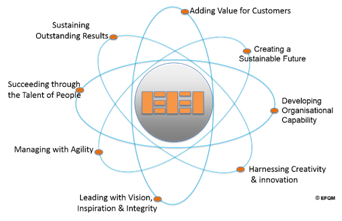
- The Model Criteria provide a framework to help organisations to convert the Fundamental Concepts and RADAR thinking into practice.

- The RADAR Logic is a simple but powerful management tool that can be applied in different ways to help drive continuous improvement.
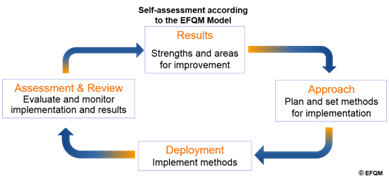
Source: http://www.efqm.org/the-efqm-excellence-model
IPMA Project Excellence Model
To help assess any project a fundamental and sound picture is required. This structure is offered by the IPMA Project Excellence Model. The Model is a benchmarking tool which helps project teams to reflect on their own strengths and potential improvement areas. The model is an adaptable and open concept. It allows many different project approaches to be used and should gain major benefits for future projects.
The model elements are based on the fundamental insights, concepts and experiences of Total Quality Management (TQM). Of course, this experience – and therefore the IPMA Project Excellence Model – shows only the status quo of current management quality. However, the model is being developed continually based on the experience of outstanding organisations and project teams.
The IPMA Project Excellence Model divides nine assessment criteria into two sections of 500 points:
Project Management:
- What is the project like?
- How is it managed?
Project Results:
What does the project achieve?
What comes out of it?
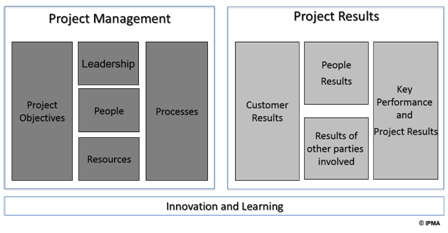
The IPMA Project Excellence Model covers the following important aspects:
Customer Satisfaction
In well-managed companies and projects, the customer – with all his/her issues – has to be the “king”. The customer alone decides on quality perception. A company project team must completely understand customer needs and wishes.
Employees’ development and participation
The complete potential of employees can only be released in an atmosphere of confidence and openness.
Partnership with suppliers
A customer-supplier relationship based on confidence and cooperation is a great asset for both sides.
Leadership
Genuine leaders form the culture of the organisation and steer resources and efforts towards excellent achievements. Therefore, leadership quality is imperative.
Social responsibility
Every excellent company needs to understand that it can never make optional decisions if they are isolated from the environment. Ethics and social responsibility play an important part in all decisions.
Processes and facts
Activities are conducted systematically as processes and they are subject to permanent improvement. Facts and clear measurements serve as a basis.
Results
To obtain lasting outstanding results, the expectations and demands of all parties involved have to be well-balanced. From this basic idea, nine criteria have been established to judge how projects progress to great achievements.
Conclusion
A technical interpretation of all Excellence models shows the following common idea:
... the 5 “cogwheels” of the enabler criteria have to fit together to power the big results wheel and thus move the shaft with the key results upwards.
... no cogwheel could be left away, or there is a break in the “power transmission”.
... no tooth can be missing on any of the cogwheels or the shaft will never move.
